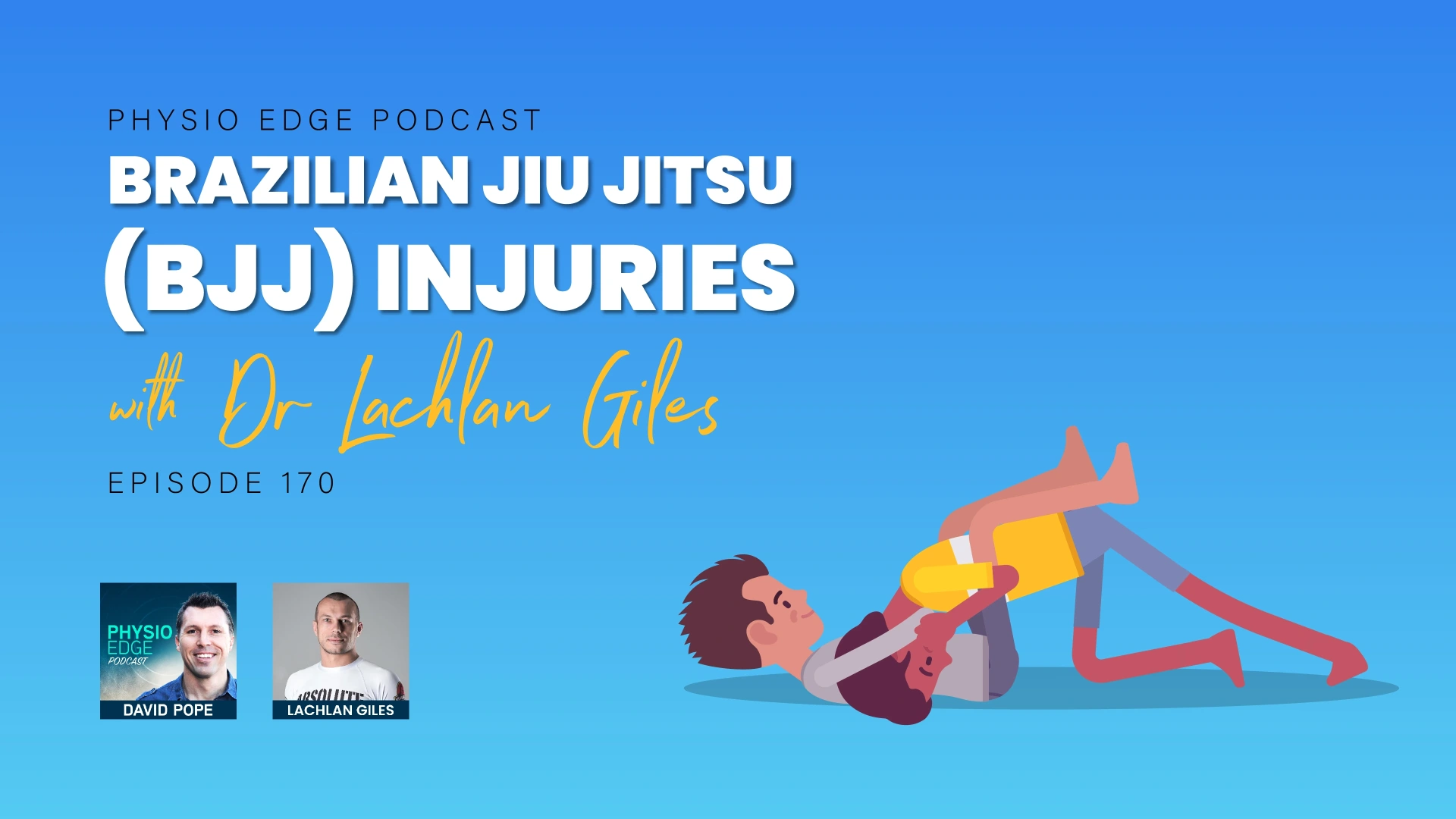170. Brazilian Jiu Jitsu (BJJ) injuries with Dr Lachlan Giles
Release Date: 04/08/2025
 174. ACJ - The hidden culprit behind stubborn shoulder pain? Physio Edge Shoulder Success podcast with Jo Gibson
174. ACJ - The hidden culprit behind stubborn shoulder pain? Physio Edge Shoulder Success podcast with Jo Gibson
Physio Edge podcast
Have any of your shoulder patients improved and then plateaued, unable to regain their full range of movement, or get rid of their painful arc? Sometimes it’s not the cuff, capsule, nerves or neck—it’s the acromioclavicular joint (ACJ) holding things back. In this episode, Jo Gibson sheds light on this often-overlooked contributor to persistent shoulder pain. From real patient case studies to the latest research and simple clinic-ready symptom modification tests, Jo shares practical strategies you can use immediately. Learn how to identify ACJ involvement, and use targeted rehab...
info_outline 173. Hip flexor pain in runners: Diagnosis, myths, and rehab. Physio Edge Track record: Running repairs podcast with Tom Goom
173. Hip flexor pain in runners: Diagnosis, myths, and rehab. Physio Edge Track record: Running repairs podcast with Tom Goom
Physio Edge podcast
Anterior hip pain is often blamed on the hip flexors, but in runners, that’s rarely the diagnosis. So how can you identify the real cause and guide patients to a safe, effective recovery? In this episode, Tom Goom (Running Physio) explores the function of the hip flexors in running, key differentials for anterior hip or groin pain, and practical rehab strategies you can use right away. You’ll discover: Why true hip flexor tendinopathy is uncommon in endurance runners Red flags and key tests to identify bone stress fractures and intra‑articular pathology Early‑stage loading strategies...
info_outline 172. Shoulder pain assessment & clinical reasoning. Physio Edge Shoulder Success podcast with Jo Gibson
172. Shoulder pain assessment & clinical reasoning. Physio Edge Shoulder Success podcast with Jo Gibson
Physio Edge podcast
Your patient presents with shoulder pain, and straight away you need to identify: Is it rotator cuff related shoulder pain, frozen shoulder, instability, or something else entirely? Is it rotator cuff related shoulder pain, frozen shoulder, instability, or something else entirely? Is the pain actually coming from the shoulder? Could it be the cervical spine? Is there a tear that needs urgent referral? Should you order imaging? Refer to a surgeon? Or confidently continue with rehab? In this podcast, Jo Gibson (Upper Limb Rehabilitation Specialist Physio) guides you through a simple,...
info_outline 171. Achilles tendon ruptures: Rehab & recovery with Prof. Peter Malliaras
171. Achilles tendon ruptures: Rehab & recovery with Prof. Peter Malliaras
Physio Edge podcast
Your patient is running, playing sport, or jumping or lunging forward - an activity with fast eccentric or concentric activity in dorsiflexion,and suddenly they feel like they’ve been kicked in the back of the leg. They might hear a snap and have difficulty weightbearing, walking and pushing off. What’s your likely diagnosis? You picked it - an Achilles tendon (AT) rupture. AT ruptures are a devastating injury that can drastically impact a patient’s ability to walk, run, or return to sport. Despite their frequency, there’s a lot of uncertainty among clinicians, patients, and even...
info_outline 170. Brazilian Jiu Jitsu (BJJ) injuries with Dr Lachlan Giles
170. Brazilian Jiu Jitsu (BJJ) injuries with Dr Lachlan Giles
Physio Edge podcast
Brazilian Jiu-Jitsu (BJJ) is a popular grappling-based martial art that uses joint locks and chokes to subdue or submit opponents. It’s an intense, physically demanding sport with complex movements and submission techniques that involve a risk of injury, particularly to the knees, shoulders, elbows, neck, and lower back. It’s important for Physiotherapists and health professionals who treat BJJ athletes to understand the different mechanisms of injury, movements and positions athletes need to be able to perform, so they can develop successful rehabilitation programs, and safely and...
info_outline 169. Beyond stretching: How to create lasting flexibility. Physio Edge Running repairs podcast with Tom Goom
169. Beyond stretching: How to create lasting flexibility. Physio Edge Running repairs podcast with Tom Goom
Physio Edge podcast
Static stretching has long been used to improve flexibility, but research shows its effects are often short-lived. So how can you help patients achieve lasting improvements? In this episode, Tom Goom (Running Physio) explores exercises you can provide to patients to increase muscle fascicle length, improve flexibility, and reduce injury risk. You’ll discover: Why static stretching alone may not create long-term flexibility gains Exercises to improve muscle length and function Key training parameters for effective flexibility training Strategies to maintain flexibility improvements...
info_outline 168. How to explain shoulder pain to patients. Physio Edge Shoulder Success podcast with Jo Gibson
168. How to explain shoulder pain to patients. Physio Edge Shoulder Success podcast with Jo Gibson
Physio Edge podcast
How do the terms we use influence a patient’s understanding of their shoulder pain, their recovery expectations, and even their treatment choices? In this episode of the Physio Edge Shoulder Success Podcast, Jo Gibson (Upper Limb Rehabilitation Specialist Physio), explores the power of language in physiotherapy and how our explanations can either support or hinder a patient’s progress. Drawing on research and real-world clinical experience, Jo discusses a compelling case study: Persistent shoulder pain after multiple treatments – A patient with years of ongoing pain, failed...
info_outline 167. Bones, them strong bones: How to use bone loading programs. Physio Edge Running repairs podcast with Tom Goom
167. Bones, them strong bones: How to use bone loading programs. Physio Edge Running repairs podcast with Tom Goom
Physio Edge podcast
Bone strength and density are vital in your running and sporting patients who can experience bone stress injuries (BSI’s), and also as patients get older and more vulnerable to falls and fractures. How can you improve bone strength in patients following a bone stress injury such as Medial Tibial Stress Syndrome or stress fractures, or in other patients that you’d like to improve bone density or strength? Traditional approaches to strength and conditioning may not always address the needs of your patients recovering from bone stress injuries. That’s where bone loading programs come...
info_outline 166. To tape or not to tape? Physio Edge Shoulder Success podcast with Jo Gibson
166. To tape or not to tape? Physio Edge Shoulder Success podcast with Jo Gibson
Physio Edge podcast
Taping: does it really help patients with shoulder pain, or is it just a brightly coloured placebo? In this thought-provoking episode of the Physio Edge Shoulder Success Podcast, Jo Gibson, upper limb rehab specialist at Rehab for Performance, unpacks the complexities of taping in shoulder rehabilitation. Drawing from the latest evidence and her extensive experience with shoulder pain, Jo shares two compelling case studies and whether taping was useful in the treatment of: Volleyball player post-stabilisation surgery – Despite passing all return-to-play criteria, this patient struggled...
info_outline 165. Busting hip pain myths with Mehmet Gem
165. Busting hip pain myths with Mehmet Gem
Physio Edge podcast
Join hosts David Pope and The Hip Physio - Mehmet Gem as they dive deep into the myths and misconceptions surrounding hip and groin pain. This podcast explores common myths about glutes and hip flexors, effective rehab exercises, and how to accurately assess and treat various hip conditions. Get free access to the "Tricky tendons" infographic series Unlock the secrets of successful tendinopathy assessment and treatment with this free infographic series for therapists. Links Chapter markes: 00:00 Intro 00:27 Getting to know Mehmet 03:11 Glute myths and...
info_outline
Brazilian Jiu-Jitsu (BJJ) is a popular grappling-based martial art that uses joint locks and chokes to subdue or submit opponents. It’s an intense, physically demanding sport with complex movements and submission techniques that involve a risk of injury, particularly to the knees, shoulders, elbows, neck, and lower back. It’s important for Physiotherapists and health professionals who treat BJJ athletes to understand the different mechanisms of injury, movements and positions athletes need to be able to perform, so they can develop successful rehabilitation programs, and safely and successfully return athletes to training. In this podcast, David Pope (APA Titled Musculoskeletal and Sports and Exercise Physio) explores BJJ injuries with Dr. Lachlan Giles—a BJJ black belt and world-class BJJ competitor, including 1st Place IBJJF Pan-Pacific Championship 2016 & 2017, 3rd place ADCC 2019 Open weight division and many more accomplishments. Lachlan is also a BJJ coach to top level competitors, including Levi Jones-Leary, Craig Jones before he moved to DDS, and a Physiotherapist with a PhD in knee pain and rehab. Lachlan shares his extensive experience treating and managing BJJ injuries, drawing from the research, as well as his clinical knowledge and personal experience as an elite grappler and BJJ coach. In this podcast, we discuss:
- The challenges physiotherapists face when treating BJJ athletes and how to adapt rehab programs for them.
- Common areas injured in BJJ.
- What commonly causes knee injuries, including LCL and ACL sprains, in BJJ.
- Different positions athletes need to get into in BJJ, why it’s important to understand these positions, and how you can use this to guide your rehab and return to sport.
- Strength vs flexibility vs conditioning? Which factors are critical in injury recovery, prevention and performance?
- Practical strategies for modifying training and load to allow injured athletes to continue training safely.
- The role of neck strengthening in protecting against neck injuries from chokes and takedowns.
- How to structure a safe return-to-play progression for knee, back, and rib injuries.
- Key factors that impact athlete recovery. When athletes can continue training, when and how to modify training and when to recommend complete rest. The impact of training style, intensity, and mindset on injury risk and longevity in the sport. How older athletes can adjust their game to have fewer injuries while continuing to train and compete. Listen to this podcast now to have a better understanding of BJJ injuries, rehabilitation, and strategies to help athletes successfully get back to or continue training and competing in BJJ.
Get free access to the "Tricky tendons" infographic series
Unlock the secrets of successful tendinopathy assessment and treatment with this free infographic series for therapists.

Links
- Improve your musculoskeletal and sports injury assessment & treatment results with a free trial Clinical Edge membership
- Click here to register and receive immediate access to the Tricky tendons infographic series
- Free Achilles tendinopathy video series with Tom Goom
- David Pope at Clinical Edge
- Download and subscribe to the podcast on iTunes
- Download the podcast in Overcast
- Listen to the podcast on Spotify
- Dr Lachlan Giles
- David Pope on Twitter
- David Pope & why I started Clinical Edge
- Review the podcast on iTunes
- Infographics by Clinical Edge
Chapters:
- 04:40 - Lachlan's PhD
- 10:06 - Can VMO be targeted with rehab?
- 14:06 - What challenges do Physios face when treating BJJ athletes?
- 17:03 - When to allow patients to continue training
- 19:35 - Different types of training
- 21:36 - Lachlan's training with an LCL injury
- 26:53 - Common injuries in BJJ
- 29:18 - Other areas injured in BJJ, and why low back pain occurs
- 33:39 - How BJJ athletes can train to stay healthy and avoid injury
- 37:05 - Getting back to training and rolling
- 42:23 - Tests before patients "invert" with their legs over their head
- 48:11 - Leg entanglement, 50/50 and leg locks
- 52:09 - Positions to use when coming back from an injury
- 53:08 - Rib and costochondral injuries
- 59:44 - Forearm periostitis




